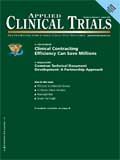FDA Seeks New Approach to Global Challenges
Applied Clinical Trials
Pharmaceutical testing and production overseas spurs call for more reliance on counterparts.
Food and Drug Administration officials recently acknowledged that its established system for ensuring the quality and safety of medical products cannot cope with significant changes in today's global medical market. More reliance on foreign producers and contractors increases the potential for diversion and fraud and weakens the ability of regulatory authorities to monitor product quality and adherence to standards.

Jill Wechsler
These developments require major changes to how FDA does business. Instead of sending out inspectors to scrutinize foreign facilities, agency officials seek to collaborate more with other regulatory authorities to make greater use of third-party auditors and to establish global information networks that can better alert officials to potential safety hazards.
The call for a new approach to food and drug regulation will have a notable impact on FDA field inspections and compliance operations, as seen in changes at the Office of Compliance (OC) in FDA's Center for Drug Evaluation and Research (CDER) that increase its focus on imports and supply chain issues. At the same time, pharma companies are supporting new collaborative efforts to ensure the quality of supplies and to prevent drug theft, diversion, and distribution of counterfeit products around the world. Increasingly tight resources at FDA and other government agencies and healthcare organizations, moreover, necessitate new approaches, as FDA faces sizeable cuts in its budget for fiscal year 2012.
Global challenges
Major difficulties in ensuring the safety and quality of imported food and medical products in a world of increasingly blurred lines between domestic and foreign production are outlined in the "Pathway to Global Product Safety and Quality," which Commissioner Margaret Hamburg unveiled in June. While the report contains few really new proposals for overseeing food and drug imports and outsourced production, the document is noteworthy for providing a comprehensive overview of the forces reshaping the global economy and biopharmaceutical product development.
To cut costs and increase productivity, FDA documents how pharma companies are shifting manufacturing and clinical testing to new locations. US pharma companies now import 80 percent of active ingredients, and contract manufacturing has more than doubled over the past decade to an estimated $46 billion business in 2010. More complex, high-risk biologics and vaccines are coming from emerging nations, instead of Western Europe. In addition, more R&D is shifting overseas; India and China already have more than 30% of the world's drug master files, and more clinical trials are taking place outside the United States and Europe. These developments make it "difficult to identify the 'source' of a product and to ensure that all players along the supply chain meet safety and quality responsibilities," the report states.
With more foreign operators to monitor, FDA concedes that it's not viable to scale up its current regulatory model, even if it had the resources to do so. The average cost of a foreign inspection is $52,000, more than twice the $23,000 outlay for a domestic site visit. More than 54 percent of foreign drug facilities went uninspected from 2002 to 2007, and the record is even worse for medical device operations overseas. Clinical site inspections dropped in 2010, compared to the previous year, particularly for foreign investigators and for drugs and biologics.
These developments also raise the specter of encouraging economically-motivated abuse, such as drug counterfeiting, fraud, and intentional adulteration. For many novice operators, the "temptation of economic gain is greater than any concern for risk to human and animal health," the FDA report observes. Americans feed these actions by purchasing more pharmaceuticals online, often from unknown sources and without appropriate oversight and safeguards. The nation already has suffered the consequences of adulterated heparin and counterfeit glucose monitoring strips, and low-quality counterfeit medicines are widely available, particularly in developing countries.
More collaboration
In response, FDA is looking to rely more on regulatory counterparts and to implement third-party inspection programs and international cooperative activities to bolster oversight of medical products. FDA officials envision drug regulators adopting a more collaborative approach, somewhat along the lines of the International Civil Aviation Organization, which promotes global standards for aviation safety. Another model is the information sharing by Interpol, the International Criminal Police Organization. Access to international data on manufacturers, contractors, and regulatory operations will help FDA identify signals and warnings of potential risks that can be monitored and addressed before they lead to public harm.
Although FDA has been engaging foreign regulatory counterparts in collaborative initiatives such as the International Conference on Harmonization (ICH) and the Pharmaceutical Inspection Co-operation/Scheme, these "are not sufficient" to deal with an increasingly complex global environment, the report concedes. What is needed are "global coalitions of regulators" that allow countries to maintain sovereignty in standards and decisions, but rely more on the work of counterparts and pool resources for managing the global biomedical inventory.
More collaboration already is emerging in Asia and other regions. Mexico and Costa Rica are accepting FDA medical device review decisions. FDA recently put a company on import alert based on an inspection report from a European agency. The European Medicines Agency (EMA) has long relied on "qualified persons" employed by drug manufacturers to verify the quality and safety of all approved drug batches, and that model is worth looking at, says OC Director Deborah Autor. She also is open to initiatives involving third-party audits for drugs, an option already authorized at FDA for medical devices and food imports.
FDA and EMA have extensive information-sharing activities involving new drug applications, drug safety reports, orphan medicines, and field inspections for active drug ingredients. A joint good clinical practices (GCP) initiative launched in September 2009 has been particularly successful, according to a June report on EMA-FDA interactions through September 2010. The two parties have exchanged GCP inspection plans, applications, and inspection outcomes to help target inspections and oversight. In addition, there have been seven joint and four observational inspections, which encourage further discussion on interpretations of findings.
Broader Third-World adoption of ICH standards for drug quality, efficacy, and safety also has gained support from pharma companies and regulatory authorities in the United States, Europe, and Japan as a way to promote global collaboration. When ICH was established in 1990, most pharmaceutical R&D and manufacturing took place in those three regions. The pharma world has changed greatly in the last 20 years, and "the continued success and relevance of ICH," said Justina Molzon, CDER Associate Director for International Programs, "will depend on a much broader use of ICH guidelines and standards."
To this end, ICH began inviting other regulatory authorities to participate in expert working groups several years ago and now is opening the way for them and Regional Harmonization Initiatives to become regular expert working group participants. In addition, the ICH Global Cooperation Group now transmits ICH deliberations and decisions to all interested parties.
Expanding compliance
The expansion of drug manufacturing and clinical research activities overseas and at home has prompted the transformation of CDER's Office of Compliance into a "super" office better equipped to deal with global issues. The reorganization will help OC officials manage a staff that has grown to 300 people, up from 118 in 2005, explained OC Deputy Director Ilisa Bernstein at the PDA pharmaceutical supply chain conference in June. The change also puts OC on a par with CDER's Office of New Drugs, Office of Pharmaceutical Science, and Office of Surveillance and Epidemiology.
Under the new organization, a string of top aides will oversee risk assessment, policy and strategic planning, and a broader range of compliance-related activities, directly under OC Director Autor. A new Office of Drug Security, Integrity & Recalls now oversees import operations, recalls, and a range of supply chain issues such as product authentication, intentional adulteration, and theft.
The Office of Scientific Investigations (OSI), which monitors clinical trial operations, bioequivalence testing, and patient protections, now has a new division of safety compliance to oversee postmarketing activities, including adverse event reporting and Risk Evaluation and Mitigation Strategies implementation. Autor considers this a logical move because these programs require an interface with the clinical side of drug approval, and OSI has a large number of MDs who can take a hard look at the clinical significance of issues related to adverse event reports.
A significant reason for the OC reorganization, Autor comments, "is to recognize the challenges of globalization" and to be able to focus more on international collaboration and data mining and risk analytics. "It fits together nicely and it's the right direction for us to move in."
Editor's Note: At press time FDA announced a major reorganization of the Commissioner's office: Autor was named FDA Deputy Commissioner for Global Regulatory Operations and Policy; Ilisa Bernstein, OC Acting Director.
Jill Wechsler is the Washington Editor of Applied Clinical Trials, (301) 656-4634 jwechsler@advanstar.com

FDA Fast Tracks Johnson & Johnson’s Nipocalimab for Fetal Neonatal Alloimmune Thrombocytopenia
March 27th 2024Johnson & Johnson is moving forward with a pair of Phase III trials of nipocalimab to reduce the risk of fetal neonatal alloimmune thrombocytopenia in alloimmunized pregnant patients.
Citius Pharmaceuticals Resubmits BLA to FDA for Lymphir to Treat Cutaneous T-Cell Lymphoma
March 19th 2024Pivotal Phase III Study 302 trial data show an objective response rate of 36.2% based on an independent review committee assessment in the treatment of relapsed/refractory cutaneous T-cell lymphoma.